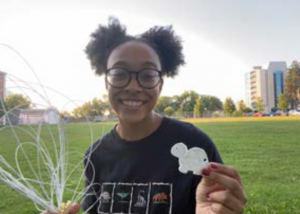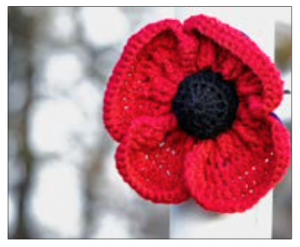YOUTH UP FRONT
Today’s educators are nurturing a generation of environmental problem-solvers and leaders. There is no greater time in history than now to work on innovative solutions to decrease the impacts of man-made issues. This series highlights the accomplishments of students who are helping to restore our planet’s fragile ecosystems.
Plastics litter the top of Mount Everest and the depths of our oceans. What’s more, due to the many types of containers, it has been revealed that only 8 to 11% of the three million tonnes produced annually in Canada are actually recycled into new products. The immense scale of this plastic pollution, however, has not daunted two grade 11 students at Saskatoon’s Bishop James Mahoney High School. Sophia LaCroix and Kai Chen personally began collecting plastic PET (polyethylene terephthalate) beverage bottles for recycling. In order to process this one type of plastic, they initiated the non-profit SK Eco Solutions, which operates outside the school.
 After receiving grants from EcoFriendly Sask and the Greater Saskatoon Catholic Schools Foundation, LaCroix and Chen purchased a PETBOT machine, thus enabling the school’s preexisting green team to carry on with the project of recycling. “The biggest hurdle we had to get over was finding the machine,” LaCroix said. This extruder is manufactured by NovaTech, a Russian company. The machine strips plastic into a coil, heats it into a filament that, in turn, provides the raw material needed for 3D printers. LaCroix explained, “We ribbonize plastic bottles and extrude it. The filament that we receive is put on a spool to be converted into the filament that is fed directly into 3D printing machines. It’s all part of this new wave of technology that tons of arts programs and schools are using.”
After receiving grants from EcoFriendly Sask and the Greater Saskatoon Catholic Schools Foundation, LaCroix and Chen purchased a PETBOT machine, thus enabling the school’s preexisting green team to carry on with the project of recycling. “The biggest hurdle we had to get over was finding the machine,” LaCroix said. This extruder is manufactured by NovaTech, a Russian company. The machine strips plastic into a coil, heats it into a filament that, in turn, provides the raw material needed for 3D printers. LaCroix explained, “We ribbonize plastic bottles and extrude it. The filament that we receive is put on a spool to be converted into the filament that is fed directly into 3D printing machines. It’s all part of this new wave of technology that tons of arts programs and schools are using.”
They both agree that seeing the machine the first time in person was shocking and surpassed all expectations. Chen stated, “It did take a lot of trial and error before we actually obtained some usable filament, but once we got that going, it was pretty amazing to see a plastic bottle turn into something so easily used.”
Currently, only community members, including the Meewasin Valley Authority, are gathering plastic bottles when they clean Saskatoon trails. Once production increases, the pair will be encouraging other local associations and public groups to contribute as well. Chen stated, “In the future, we’re hoping to have at least 50% of our filament come directly from littered bottles.”
 LaCroix added, “It’s really overwhelming when you see just bags and bags of plastic bottles, which we don’t think about too often as being litter. But once you actually go out and search for them, you realize there’s a lot more than you could have anticipated.”
LaCroix added, “It’s really overwhelming when you see just bags and bags of plastic bottles, which we don’t think about too often as being litter. But once you actually go out and search for them, you realize there’s a lot more than you could have anticipated.”
Their aim is to donate the filament to schools and other organizations using 3D printers in education. As LaCroix stated, “Overall, we hope to inspire other students with our work, not only to take on this project, but also to find new ways to innovate and reduce plastic waste as well as their own carbon footprint. Many people want to do large-scale environmental projects; however, there are many things citizens can accomplish in just their everyday lives.”
When the two teens prepare to leave Saskatoon for their post-secondary education, they will put trust in their school’s green team to keep ProjectPET going.
MORE PLASTIC SOLUTIONS
Recycling, however, is only part of the solution. Our throwaway society is leaving oceans, lakes, and rivers in peril. The plastic packaging industry needs to shoulder more responsibility, but so do individuals—we all must focus on “Reduce and Reuse.” Teachers can help put pressure on the Canadian Plastic Packaging Association by discussing and sharing various ways to eliminate single-use containers.
It’s time to join the “Break Free from Plastic Movement” by recognizing all throwaway plastics. For example, with Remembrance Day on the horizon, citizens can honour our veterans by saving poppies to reuse again and simply make a donation. This movement embraces the rising circular economy.
On a global scale, consider the thousands of disposable, petroleum-based poppies that are manufactured, boxed and transported. For those new poppies that will be manufactured, students can contact, admin@ poppyfactory.org and urge them to utilize recycled plastics and create a method to reuse the green plastic stems.
Undoubtedly the poppy’s symbolism serves as a reminder of those who served to protect our freedom. However, servicemen and women would be outraged at the way we use the freedom they gave us to litter the soil, pollute the air, and contaminate the seas on which they so gallantly fought. It would be more meaningful if students thoughtfully created their own poppies from recycled or natural materials.
The national program, No Stone Left Alone Memorial Foundation, was launched in Edmonton in 2011 to engage students to leave a poppy on each veteran’s headstone. If thousands of poppies are left unattended, would they become a problem? Thankfully, National Coordinator, Michelle Koch said, “All visible poppies are picked up, typically within a week of being placed. As snow often obscures some, the remainder are collected in the spring by our volunteers or by cemetery maintenance staff. Poppies are cleaned and stored for reuse the next year.” Koch added that they are continually looking for more eco-friendly alternatives to plastic by suggesting students make ones from paper and paint poppies on stones.
 For students wishing to knit or crochet a poppy, many patterns are available online. Designing crafted ones from wool, fabric, or paper can become a classroom art project. Any poppies left on the ground made from these natural materials would eventually decompose or be picked up by birds for nest making in the spring. All of which symbolizes the continuation of life.
For students wishing to knit or crochet a poppy, many patterns are available online. Designing crafted ones from wool, fabric, or paper can become a classroom art project. Any poppies left on the ground made from these natural materials would eventually decompose or be picked up by birds for nest making in the spring. All of which symbolizes the continuation of life.
Although the red poppy is most commonly worn, the white poppy can also be displayed. For over 80 years, white has been worn to symbolize remembrance and serve as a commitment to peace.
Related Links
https://globalnews.ca/news/7785574/saskatoon-teens-pop-bottles-3d-printer-filament/
https://www.reuters.com/article/us-coca-cola-plastic/coke-pepsi-nestle-top-makers-of-plastic-waste-greenpeace-idUSKCN1MJ1FM
https://circularinnovation.ca
https://www.breakfreefromplastic.org
https://www.nostoneleftalone.ca/teacher-resources
https://www.ppu.org.uk/remembrance-white-poppies
ABOUT THE AUTHOR
Larraine Roulston
Larraine writes illustrated adventure books on composting and pollinating for children. To view, visit: castlecompost.com
Featured in Canadian Teacher Magazine’s 2021 issue.












